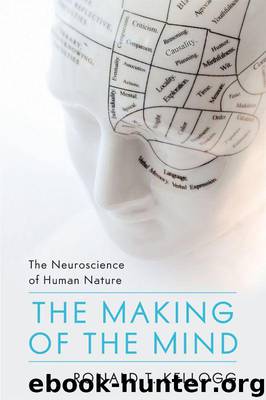The Making of the Mind: The Neuroscience of Human Nature by Kellogg Ronald T

Author:Kellogg, Ronald T. [Kellogg, Ronald T.]
Language: eng
Format: mobi
Publisher: Prometheus Books
Published: 2013-07-15T16:00:00+00:00
FEAR AS A PRIMAL EMOTION
Perhaps the emotion best understood by science is fear. Although its valence is clearly negative, fear is a beneficial emotion in motivating avoidance of danger. Its adaptive value in keeping organisms alive and able to reproduce is likely the reason why it emerged so early in the evolution of life. Fear can be observed throughout the animal kingdom, from fruit flies to people. Reptiles, fish, and all mammals exhibit a phenomenon known as fear conditioning, which has provided neuroscientists with a window into the specific neural circuits that mediate the bodily response and subjective feeling of fear.
A laboratory rat is first played a sound that has little if any impact on its blood pressure or its tendency to freeze in place, ceasing movement until danger has passed. This sound then is presented as a conditioned stimulus (CS) that precedes a painful shock, the unconditioned stimulus (UCS) that automatically generates fear, as can be seen in a sharp spike in blood pressure and several seconds of freezing in place. After several of these pairings of CS and USC, classical fear conditioning results in the same physiological changes when only the sound or CS is presented by itself. This animal model of fear conditioning has provided a way to determine the specific regions of the brain involved in the experience of fear.
An understanding of fear requires an integrated view of the limbic system and other parts of the brain.6 Although the limbic structures of the amygdala and the hippocampus are essential parts of fear conditioning, the diencephalon and telencephalon also play a role. Specifically, the sound follows a pathway from the ear via the auditory nerve to the midbrain then to the thalamus and finally to the auditory neocortex. The output from the thalamus also goes to a cluster of neurons in the amygdala of the limbic system called the lateral nucleus. The signals from the auditory thalamus to the lateral nucleus offer a high-speed connection to the initiation of fear and the freezing of movement. Although the thalamus cannot process the identity of the stimulus that launched a fear response, it can quickly, in a single step, link to the critical structure of the amygdala.7
At the same time, a parallel computation is underway in the neocortex, where detailed and accurate representations of the external world are constructed for conscious perception.8 This involves connections from the auditory thalamus to the auditory neocortex and then back to the amygdala. Many neural links are involved in this neocortical pathway, and so the registration of fear in the amygdala takes more time than via the subcortical pathway. Imagine walking in the woods in autumn and seeing a curved object lying in the leaves and hearing the soft sound of leaves rustling. Before we are able to identify the object causing the sound as a snake, the subcortical circuit has already jacked up our blood pressure and frozen our movements or prompted a jump backward away from the threatening sound.
Although the amygdala is essential to fear conditioning, another kind of learning is also taking place.
Download
This site does not store any files on its server. We only index and link to content provided by other sites. Please contact the content providers to delete copyright contents if any and email us, we'll remove relevant links or contents immediately.
When Breath Becomes Air by Paul Kalanithi(7280)
Why We Sleep: Unlocking the Power of Sleep and Dreams by Matthew Walker(5668)
Paper Towns by Green John(4179)
The Immortal Life of Henrietta Lacks by Rebecca Skloot(3835)
The Sports Rules Book by Human Kinetics(3602)
Dynamic Alignment Through Imagery by Eric Franklin(3505)
ACSM's Complete Guide to Fitness & Health by ACSM(3476)
Kaplan MCAT Organic Chemistry Review: Created for MCAT 2015 (Kaplan Test Prep) by Kaplan(3431)
Introduction to Kinesiology by Shirl J. Hoffman(3308)
Livewired by David Eagleman(3140)
The River of Consciousness by Oliver Sacks(3001)
Alchemy and Alchemists by C. J. S. Thompson(2918)
The Death of the Heart by Elizabeth Bowen(2912)
Descartes' Error by Antonio Damasio(2748)
Bad Pharma by Ben Goldacre(2738)
The Gene: An Intimate History by Siddhartha Mukherjee(2502)
Kaplan MCAT Behavioral Sciences Review: Created for MCAT 2015 (Kaplan Test Prep) by Kaplan(2495)
The Fate of Rome: Climate, Disease, and the End of an Empire (The Princeton History of the Ancient World) by Kyle Harper(2445)
The Emperor of All Maladies: A Biography of Cancer by Siddhartha Mukherjee(2440)
